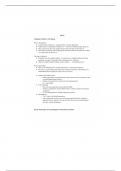Class notes
Psy 101 Comprehensive Notes
- Course
- Psychology 101
- Institution
- Virginia Commonwealth University
This is a comprehensive and detailed note that contains key concepts, diagrams and definitions for Psy 101. *Essential Study Material!! *For you, at a price that's fair enough!!
[Show more]



